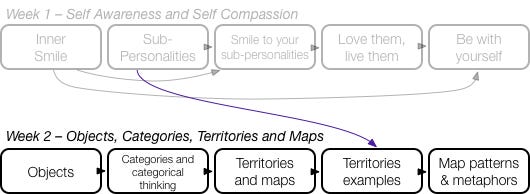Objects, Categories, Territories & Maps Overview
For BFNow Self-Study Module 2
[This is part of the BFNow Self-Study section of this site. For more about this section, please look at About BFNow Self-Study and BFNow Self-Study Orientation.]
In this module we’re going to dive deep into the human operating-system (abbreviated here as humanOS) and explore how we interpret the world around us and co-create our own personal reality.
We’re going to slow down and notice processes of perception and thinking that are so familiar and so automatic that we rarely see them. We’ll get to see the enormous usefulness of these processes but also their limitations. We’ll then explore some tools that can take us past those limitations.
We are going to explore two modes of perceiving and thinking.
The first mode is based on objects and categorical thinking. Everyone uses this mode since it’s “hard-wired” into our brains and often very practical. It meshes well with language, was strong in the Empire Era, became even more dominant with the Age of Enlightenment and is still dominant today.
The second mode is based on mappable territories and system thinking. Not everyone uses this mode although we all have the brain functions to do so. It uses both language and visuals. I see it as an important partner to the first mode in the Planetary Era.
I’d like to emphasize that the goal here isn’t to replace the object/categorical mode with the second mode. That would be too categorical 🙂 . Rather, it’s to expand the toolkit and go beyond the monopoly that the object/categorical mode has in many people. We want to become adept at both modes and able to apply each as appropriate.
I’m going to provide more background in the explorations for this module. If you find that helpful, great. If you find some of the material challenging, don’t expect to assimilate it all in one sitting. Many of the new concepts here will make increasing sense as we go through the module.
You may find it helpful to read the experientials first (so you know where you are going) and then come back to the background and then reread and do the experiential. Keep it enjoyable. In any case, the important thing is your experience and your discoveries.
For this module I’d like to recommend that you look at some specific sections in the Foundation Stones videos:
For Exploration 1, Objects: Human Operating-System Literacy, Part 4, starting at 11:46 and going 7 minutes for objects; and Human Operating-System Literacy, Part 2, starting at 9:39 and going 3 minutes for mind bundles.
For Exploration 2, Categories & Categorical Thinking: Human Operating-System Literacy, Part 4, starting at 3:38 and going to 4:54 for categories.
For Exploration 3, Territories and Maps: System Literacy Part 1, starting at 12:34 and going to 16:19 for the distinction between territories and maps. Keep going past 16:19 for how this connects to the concept of systems.
The links should take you right to the start of each section. These links are in the Exploration Pages but I’m posting them now so that you have the option of looking at them whenever it fits into your schedule.
A visual map for this modules’s content
Here’s a diagram with the titles for each Exploration Page plus the previous module for context. Each module I’ll add to this diagram so you can stay oriented to how each Exploration Page builds on those that went before.
Key Concepts and Terms
Just as with last module, I’d like to offer you a set of key concepts and terms that I encourage you to pay special attention to in this module. Many, but not all, of these are also in the titles of the Exploration Pages:
objects
mind bundles
categories and categorical thinking
territories
maps
what pathway, where pathway
thing vs object
composites, layers, sliders, spaces, fields, systems
Module 2 Explorations
Categories & Categorical Thinking – Exploration 2
Territories & Maps – Exploration 3


